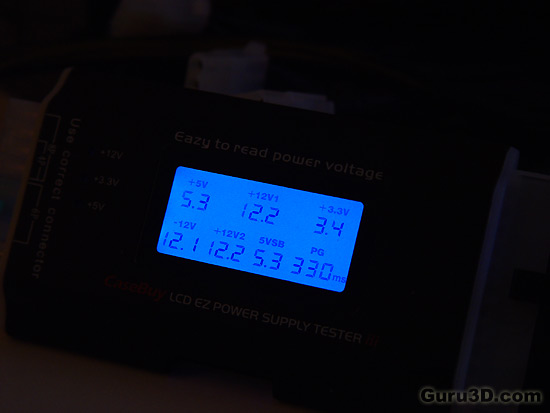Page 5
The Test
How do you actually objectively test a PSU ? It's incredibly difficult to be honest. Unless you have serious professional equipment it's very hard to test and most of all stress a PSU with so much Wattage. Firstly we do a quick test with this nifty new gadget I have been testing. With a power supply tester quickly check if the voltage rails are all working properly and what amount of voltage they are delivering without a PC connected to it. Let's have a look:

This is an example of how that test is being done. Let me zoom in a little as the LCD screen is a little overexposed.

Okay so we can immediately see that all primary voltage rails are working beautifully. All Voltages fall directly within ATX specifications, so this is looking good. This however is not an objective enough tool to measure voltages at all.
For those that are wondering what the PG delay (330ms) being displayed on the screen is, here we go. Power Good (PG) Delay and Off Delay: It takes a power supply at least 100ms to completely power up before it can offer the proper DC voltages to the computer. The computer will not attempt to turn on until the power supply is finished powering up and sends a Power Good (PG) signal to the motherboard via a PG terminal. On power up the Power Good (PG) terminal is polled for a brief period before the PC turns on to check the status of the power supply. Only after the +5V and +3.3V rails are above threshold does the PG signal go "high." The PG signal stays on until the PC is ready to power off. The period of delay between switching on the PS and the actual application of power is the PG delay. Typical values are 100-350ms. The PG delay of the power supply should roughly match the PG delay specification of the motherboard or power on problems may occur.
So this is within specifications. Let's do a real-world test.
